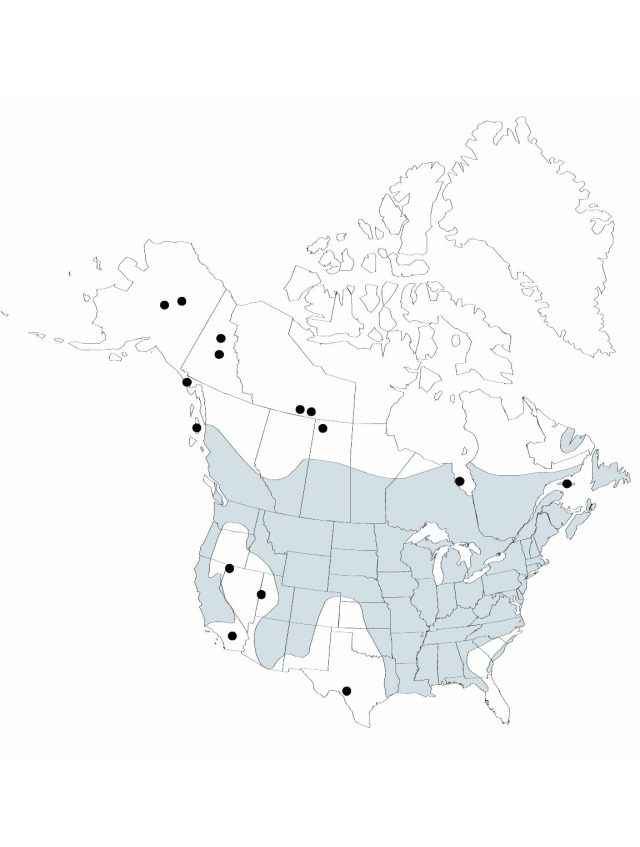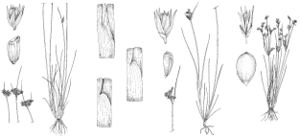Difference between revisions of "Juncus tenuis"
Sp. Pl. 2(1): 214. 1799.
FNA>Volume Importer |
FNA>Volume Importer |
||
| Line 12: | Line 12: | ||
|name=Juncus bicornis | |name=Juncus bicornis | ||
|authority=Michaux | |authority=Michaux | ||
| − | }}{{Treatment/ID/Synonym | + | }} {{Treatment/ID/Synonym |
|name=Juncus bicornis var. williamsii | |name=Juncus bicornis var. williamsii | ||
|authority=(Fernald) Victorin | |authority=(Fernald) Victorin | ||
| − | }}{{Treatment/ID/Synonym | + | }} {{Treatment/ID/Synonym |
|name=Juncus macer | |name=Juncus macer | ||
|authority=forma williamsii (Fernald) F. J. Hermann | |authority=forma williamsii (Fernald) F. J. Hermann | ||
| − | }}{{Treatment/ID/Synonym | + | }} {{Treatment/ID/Synonym |
|name=Juncus macer | |name=Juncus macer | ||
|authority=unknown | |authority=unknown | ||
| − | }}{{Treatment/ID/Synonym | + | }} {{Treatment/ID/Synonym |
|name=Juncus macer var. williamsii | |name=Juncus macer var. williamsii | ||
|authority=(Fernald) Fernald | |authority=(Fernald) Fernald | ||
| − | }}{{Treatment/ID/Synonym | + | }} {{Treatment/ID/Synonym |
|name=Juncus tenuis var. bicornis | |name=Juncus tenuis var. bicornis | ||
|authority=(Michaux) E. Meyer | |authority=(Michaux) E. Meyer | ||
| − | }}{{Treatment/ID/Synonym | + | }} {{Treatment/ID/Synonym |
|name=Juncus tenuis var. multicornis | |name=Juncus tenuis var. multicornis | ||
|authority=E. Meyer | |authority=E. Meyer | ||
| − | }}{{Treatment/ID/Synonym | + | }} {{Treatment/ID/Synonym |
|name=Juncus tenuis var. williamsii | |name=Juncus tenuis var. williamsii | ||
|authority=Fernald | |authority=Fernald | ||
| Line 47: | Line 47: | ||
|habitat=Exposed or shaded sites in soils ranging from sandy to clayey under moist or drier conditions, oftentimes these sites naturally or otherwise disturbed (e.g., game or human trails) | |habitat=Exposed or shaded sites in soils ranging from sandy to clayey under moist or drier conditions, oftentimes these sites naturally or otherwise disturbed (e.g., game or human trails) | ||
|distribution=Alta.;B.C.;Man.;N.B.;N.S.;Ont.;P.E.I.;Que.;Sask.;Ala.;Alaska;Ariz.;Ark.;Calif.;Colo.;Conn.;Del.;D.C.;Fla.;Ga.;Idaho;Ill.;Ind.;Iowa;Kans.;Ky.;La.;Maine;Md.;Mass.;Mich.;Minn.;Miss.;Mo.;Mont.;Nebr.;Nev.;N.H.;N.J.;N.Mex.;N.Y.;N.C.;N.Dak.;Ohio;Okla.;Oreg.;Pa.;R.I.;S.C.;S.Dak.;Tenn.;Tex.;Utah;Vt.;Va.;Wash.;W.Va.;Wis.;Wyo.;introduced worldwide. | |distribution=Alta.;B.C.;Man.;N.B.;N.S.;Ont.;P.E.I.;Que.;Sask.;Ala.;Alaska;Ariz.;Ark.;Calif.;Colo.;Conn.;Del.;D.C.;Fla.;Ga.;Idaho;Ill.;Ind.;Iowa;Kans.;Ky.;La.;Maine;Md.;Mass.;Mich.;Minn.;Miss.;Mo.;Mont.;Nebr.;Nev.;N.H.;N.J.;N.Mex.;N.Y.;N.C.;N.Dak.;Ohio;Okla.;Oreg.;Pa.;R.I.;S.C.;S.Dak.;Tenn.;Tex.;Utah;Vt.;Va.;Wash.;W.Va.;Wis.;Wyo.;introduced worldwide. | ||
| − | |discussion=<p>Juncus tenuis occurs throughout North America. It is particularly abundant in northeastern United States and eastern Canada, although infrequent in the south and west.</p><!-- | + | |discussion=<p><i>Juncus tenuis</i> occurs throughout North America. It is particularly abundant in northeastern United States and eastern Canada, although infrequent in the south and west.</p><!-- |
| − | --><p>Through the use of isozyme electrophoresis, hybridization can be demonstrated between various members of the Juncus tenuis complex, including Juncus tenuis, J. anthelatus, J. interior, J. secundus, and J. dichotomus (R. E. Brooks, unpubl.). Juncus ××oronensis is thought to be a hybrid between J. tenuis and J. vaseyi in the northeast.</p> | + | --><p>Through the use of isozyme electrophoresis, hybridization can be demonstrated between various members of the <i>Juncus tenuis</i> complex, including <i>Juncus tenuis</i>, <i>J. anthelatus</i>, <i>J. interior</i>, <i>J. secundus</i>, and <i>J. dichotomus</i> (R. E. Brooks, unpubl.). <i>Juncus</i> ××oronensis is thought to be a hybrid between <i>J. tenuis</i> and <i>J. vaseyi</i> in the northeast.</p> |
|tables= | |tables= | ||
|references= | |references= | ||
| Line 71: | Line 71: | ||
|publication year=1799 | |publication year=1799 | ||
|special status= | |special status= | ||
| − | |source xml=https://jpend@bitbucket.org/aafc-mbb/fna-data-curation.git/src/ | + | |source xml=https://jpend@bitbucket.org/aafc-mbb/fna-data-curation.git/src/8f726806613d60c220dc4493de13607dd3150896/coarse_grained_fna_xml/V22/V22_481.xml |
|genus=Juncus | |genus=Juncus | ||
|subgenus=Juncus subg. Poiophylli | |subgenus=Juncus subg. Poiophylli | ||
Revision as of 16:58, 18 September 2019
Herbs, perennial, tufted, 1.5–5 dm. Rhizomes densely branching. Culms few–20. Leaves basal, (1–)2–3; auricles 2–5 mm, apex acute, membranous; blade flat, 3–12 cm × 0.5–1 mm, margins entire. Inflorescences 5–40-flowered, borne congested or branch internodes ca. as long as tepals, ssomewhat loose, 1–5 cm; primary bract usually longer than inflorescence. Flowers: bracteoles 2; tepals greenish, lanceolate, 3.3–4.4 mm; outer and inner series nearly equal; stamens 6, filaments 0.5–0.9 mm, anthers 0.1–0.2 mm; style 0.1–0.2 mm. Capsules tan or light brown, 1-locular to pseudo-3-locular, ellipsoid, (3.3–)3.8–4.7 × (1.1–)1.3–1.7 mm, nearly equal to tepals. Seeds tan, ellipsoid to lunate, (0.52–)5.5–0.65(–0.7) mm, not tailed. 2n = 80.
Phenology: Flowering spring–early summer.
Habitat: Exposed or shaded sites in soils ranging from sandy to clayey under moist or drier conditions, oftentimes these sites naturally or otherwise disturbed (e.g., game or human trails)
Distribution

Alta., B.C., Man., N.B., N.S., Ont., P.E.I., Que., Sask., Ala., Alaska, Ariz., Ark., Calif., Colo., Conn., Del., D.C., Fla., Ga., Idaho, Ill., Ind., Iowa, Kans., Ky., La., Maine, Md., Mass., Mich., Minn., Miss., Mo., Mont., Nebr., Nev., N.H., N.J., N.Mex., N.Y., N.C., N.Dak., Ohio, Okla., Oreg., Pa., R.I., S.C., S.Dak., Tenn., Tex., Utah, Vt., Va., Wash., W.Va., Wis., Wyo., introduced worldwide.
Discussion
Juncus tenuis occurs throughout North America. It is particularly abundant in northeastern United States and eastern Canada, although infrequent in the south and west.
Through the use of isozyme electrophoresis, hybridization can be demonstrated between various members of the Juncus tenuis complex, including Juncus tenuis, J. anthelatus, J. interior, J. secundus, and J. dichotomus (R. E. Brooks, unpubl.). Juncus ××oronensis is thought to be a hybrid between J. tenuis and J. vaseyi in the northeast.
Selected References
None.
